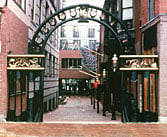69 Norman St.
Everett, MA 02149
Phone: 617-389-8440
Fax: 617-389-2831
69 Norman St.
Everett, MA 02149
Phone: 617-389-8440
Fax: 617-389-2831

Cleanliness is very important to achieve proper and complete galvanizing of castings. Thorough abrasive cleaning is the most effective method of treatment for the removal of foundry sand and impurities. Conventionally, this is accomplished by grit shot, or sand blasting. Grit blasting or a combination of grit and shot is generally preferred. Usually, castings are cleaned at the foundry since most galvanizers do not have abrasive blasting facilities.
Conventional acid cleaning process employed by most galvanizers does not clean castings well because sand and other surface inclusions are not removed by hydrochloric or sulfuric acid. After castings have been abrasively cleaned, they may then be flash pickled to prepare them for galvanizing.
Galvanizing sound, stress-free castings with good surface finish will produce high quality galvanized coatings. The following design and preparation rules should be applied for castings to be galvanized:
Duncan Galvanizing, Corp. 69 Norman Street, Everett, MA 02149 Phone: 617-389-8440
© 2018 Duncan Galvanizing, Corp. All Rights Reserved Privacy Policy Site Map